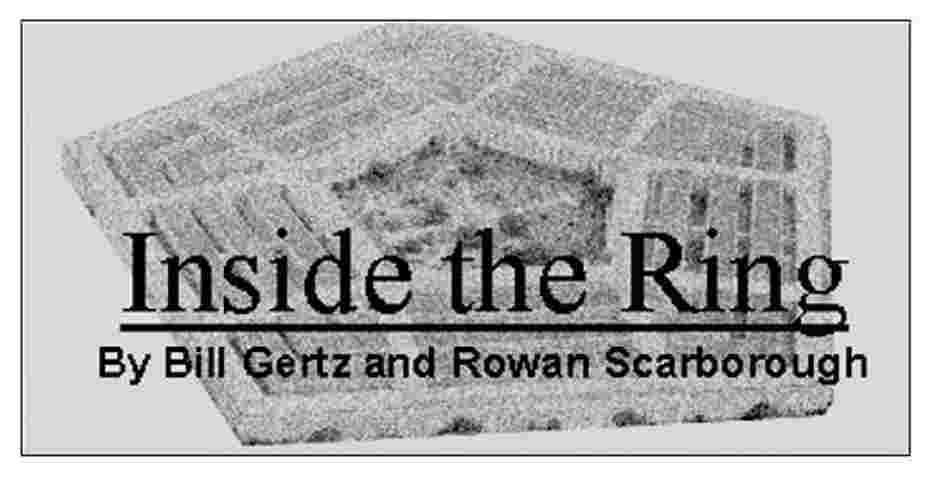|
Return to
|

|
March 21, 2003
Notes from the Pentagon
Iraqi CW shells
The rounds were identified as chemical weapons-capable shells with slots where a vial of nerve agent or biological-weapons dust is inserted before firing.
No evidence of the actual chemical or biological agents has been spotted so far. Officials said the weapons of mass destruction vials are kept separate from the artillery shells and then brought to the units before being fired.
The artillery units with the special shells were bombed Wednesday in southern Iraq in a pre-emptive strike. Officials believe the Iraqis, if they use weapons of mass destruction, will draw on their hidden stocks of VX nerve agent, an extremely potent poison.
Military ruler
The Arabic-speaking West Point graduate would essentially run the country while the United States maintained order and then slowly handed off power to Iraqi citizens.
Retired Army Lt. Gen. Jay Garner, who directs the Pentagon's office of Iraqi reconstruction, is now in Kuwait readying his team, which will follow the ground troops all the way to Baghdad.
Gen. Abizaid is helping to direct the war from Central Command war headquarters in As Saliyah, Qatar.
One of three regional rulers in post-Saddam Iraq has been designated. She is career Foreign Service Arabist Barbara Bodine, who last served as U.S. ambassador to Yemen. She will run civilian affairs in Baghdad and central Iraq, along with two other U.S. regional administrators.
Miss Bodine's appointment has angered some FBI and law enforcement officials because of her role in hampering the FBI's investigation of the October 2000 al Qaeda bombing of the destroyer USS Cole in Aden, Yemen.
She clashed with FBI counterterrorism official John O'Neill during the probe. She blocked Mr. O'Neill from returning to Yemen after a trip back to the United States, scuttling an aggressive investigation into the blast. Mr. O'Neill retired from the FBI and was killed in the September 11 World Trade Center attack.
Bogus intelligence
Contrary to news reports this week praising Mohammed's role in supplying information about al Qaeda terrorism, officials said Mohammed appears to be supplying disinformation designed to fool U.S. intelligence, as well as information that is accurate but already widely known.
"What he's telling us has been in the press and has been known well before he was captured," one official told us. "He's trying to deceive his interrogators."
For example, Mohammed said that Osama bin Laden picked the targets attacked September 11, something that was known from other intelligence and from a videotape of bin Laden himself.
Other information on al Qaeda plans provided by Mohammed also were known from other intelligence that has been made public.
Quake or nuke
That pessimism was at work recently when the ground shook in China's remote western Xinjiang province on Feb. 24.
U.S. intelligence agencies at first thought that China had conducted an unannounced underground nuclear test at its Lop Nur testing facility in the area. Analysts at first feared they had been caught napping again, as happened with India's underground nuclear test in May 1998, which was a major U.S. intelligence failure.
The event in Xinjiang was in fact an earthquake measuring 6.8 on the Richter scale. The quake killed 263 persons and injured 4,000 others.
Admiral's war message
"You have worked very hard preparing for this moment," Adm. Keating said. "You are ready. For some of you, this is a culmination of years, decades perhaps, of training. For others, this is your first exposure to the frightening reality of armed conflict.
"In any case, you will be called upon for sacrifice, for strenuous labor, for gut-wrenching, split-second decisions. You will make the right call. You will find a reservoir of strength and wisdom. I know you will because you have been schooled in the traditions of our glorious service, our United States Navy."
The strike-fighter pilot added that "it is time for us to go to work."
"Do so aggressively, intelligently, with audacity and courage. Go fully confident in the knowledge that you have earned the support of your countrymen and of millions of freedom-loving people around the world."
The Navy has deployed five carrier battle groups, which kicked off the war Wednesday night by firing more than 40 Tomahawk weapons into Baghdad and other sites.
Bunker buster
In a recent prewar press conference, Mr. Rumsfeld said Saddam put civilians in a military command bunker knowing allied planes would eventually strike it.
Sure enough, on Feb. 13, 1991, an Air Force jet attacked the communications command bunker with a penetrating bomb. At daylight, the Iraqi regime displayed the dead civilian bodies to the international media as an example of America's murderous ways.
In his new book, "War with Iraq: Critical Lessons," retired Air Force Lt. Gen. Buster Glosson writes a detailed description of how the target, No. L30, was chosen.
"Why were civilians in the bunker?" asks Gen. Glosson, who designed the air campaign. "At this point in the war, how likely was it that people would go to a bunker on their own when they could very easily see we were only bombing things of military significance in Baghdad. In other words, the safest place to be in Baghdad was in an apartment complex or in a housing area."
He answers his own question: "Saddam did it on purpose. Saddam wouldn't have cared about the fact that a lot of people that were killed were dependents of the military and the intelligence service. That fact was irrelevant to him. All life, except his own, is irrelevant to him."
|
|
Inside the Ring Archives
1999 Columns 2000 Columns 2001 Columns 2002 Columns 2003 Columns |